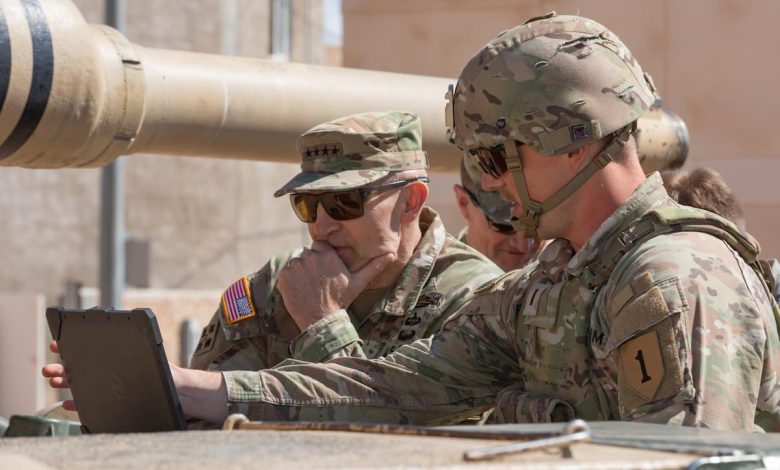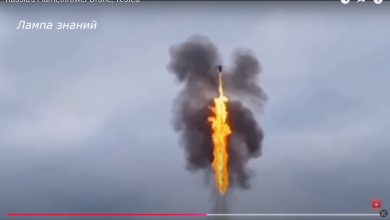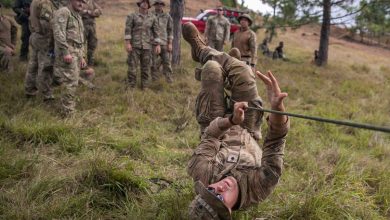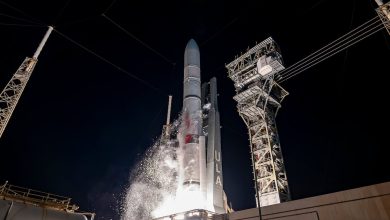Trial by fire: How the Army banks on frontline units to test new gear

When learning recently that a prototype of the Army’s new air and missile defense radar was performing significantly better in tests than the old Patriot radar, Army Chief of Staff Gen. Randy George had an idea.
Why not send the Raytheon-made Lower Tier Air and Missile Defense Sensor, or LTAMDS, to units stationed in the Pacific, the Middle East or Europe to get a sense of how the new equipment works in field, he suggested.
The process would essentially outsource service test and evaluation procedures currently confined to controlled environments in the United States to what the Army calls the “tactical edge,” one step in a wider transformation initiative that prizes change driven by the deployed.
“We bought several prototypes. We know what that capability is – whether it’s three times better or five times better, it’s better than what we have and it may not be exactly where we [want to be] at, but how can we take the same approach to putting it inside of our formation,” George said in a recent interview with Defense News.
He is now waiting for a briefing coming soon on how the Army could move more quickly with LTAMDS.
“It’s not how we normally do business,” he said, but the approach is gaining traction, propelled by a shared understanding that the pace of fielding new capabilities is the key benchmark for winning wars. “We can’t use old hardware processes when we can do things differently nowadays.”
After a series of devastating program failures, the Army has made major moves over the last decade to try to modernize its force faster, from the creation of a four-star command focused on pushing modernization efforts to the finish line, to the establishment of an office in charge of rapidly developing tech in some of the most challenging areas like hypersonic flight.
Over the years, Army officials have called for dramatic cultural changes within its modernization and acquisition communities in order to get things done, but even with nearly a decade of trying reform measures, lack of funding and red tape can still serve as roadblocks.
George became Army chief in the fall of 2023, entering the job with a reputation of bucking the status quo.
As a brigade commander in Afghanistan, George was known as the guy who outfitted his entire brigade with lighter equipment including non-standard, high-quality hiking boots because they were better than the standard-issue footwear.
At the Pentagon, George continued on that path.
He canceled two major development programs — the Future Attack Reconnaissance Aircraft and the Extended Range Cannon Artillery system — in favor of other avenues. And he did it before the programs entered the costlier phases of development and production.
George has scrapped legacy programs like the Shadow Unmanned Aircraft System in favor of a wide variety of commercial-off-the-shelf options while still pursuing a tactical UAS competition to replace the older system.
He has also worked to inject nascent capabilities into operational environments at a larger scale, compared to small soldier touchpoint events of the past, in order to understand if novel equipment can work as intended and to gauge the second-order effects on the organizations tasked with absorbing it.
He calls this effort “Transforming in Contact.”
“When the chief is talking about transforming in contact, if you take a step back, he’s talking about changing culture in the United States Army. He’s changing culture at the tactical edge. He’s changing culture with the acquisition process. He’s changing culture with the requirements process,” Lt. Gen. Karl Gingrich, whose job is pairing funding with programs as chief of the G-8 staff, told Defense News.
“We’re seeing that. We’re seeing [the Army] implement it, look at themselves on the battlefield,” he said. “They are learning, they are changing their tactics, techniques and procedures.”
Flexible Funding
Earlier this year, George began discussing the possibility of the Army asking for more flexible funding in its budget for certain capabilities. Such requests are usually touchy subjects with lawmakers, who fear losing oversight outside of the yearly appropriations cadence, a perception the chief has sought to counteract.
“I think everybody recognizes that we have to change,” he said in the recent interview ahead of the Association of the U.S. Army’s annual conference. “What we’re doing is we are now going to fund a capability rather than a specific program.”
The three target capabilities the Army is pursuing for flexible funding in the fiscal 2026 budget request will be unmanned aircraft systems, counter-UAS and electronic warfare. In future years, the Army is considering a more flexible budgeting approach with network capability as well, George noted.
“The chief and I feel very strongly that we need to invest more in … unmanned aerial systems, counter-unmanned aerial systems and electronic warfare,” Army Secretary Christine Wormuth said at the Defense News Conference in September. “When you look at what’s happening in Ukraine, we look at the lessons learned from Ukraine, clearly the role of drones, the role of capabilities to take down drones, that is going to be hugely important.”
In essence, the Army is asking to buy capability, “not things,” Alex Miller, the Army chief’s technology officer, told Defense News.
“What that allows is, generally, everyone races to be the number one provider of a thing, but the flexibility lets multiple contenders in the market and gives the Army some flexibility if a performer is not performing, if they’re not being a good teammate, we cut them loose,” he said. “And if other people come into the market, because we want to encourage that, we can bring them in as teammates.”
The Army is also looking at gaining more flexibility in research-and-development funding accounts in future years, George said.
While flexible funding means moving money around to buy specific capabilities, “we don’t want anybody to think that we’re doing things willy-nilly, and we don’t,” George said.
But Congress also needs to allow the Army to make adjustments that, for example, might cost more. “If you can imagine, [if] industry out there had to go and ask permission to make a software adjustment and it took 90, 120, 180 days, things would stop working,” George said.
The Army is working with Congress on the proper notification system that will allow lawmakers and congressional staff to see what the Army is doing and have a forum to ask questions or flag specific activity, Gingrich said.
In one way, flexible funding is just “consolidation and streamlining” line items in the base budget associated with drones, counter-drone capabilities and electronic warfare, Army Under Secretary Gabe Camarillo said in a recent interview. That consolidation “would give us much more flexibility within certain program line items to do more competitions, to be able to insert technology and to be able to procure from multiple vendors after a competition, to be able to pivot and react to emerging threats and shifting technologies at the pace that we need to.”
Generating requirements
The Army has struggled in the past to lock in requirements but maintain enough flexibility as it progresses through technology development for new weapons systems. Requirements were too numerous, rigid or specific, and when they could not be met programs were canceled.
Through Army Futures Command, or AFC, the process for establishing requirements has changed. Rather than setting rigid requirements, the service has begun to adopt characteristics it is looking for in a capability and is using prototyping to understand what is possible.
Command officials now start the process with a statement outlining needs and desired characteristics, a few pages of prose, articulating the problem the Army wants to solve and what it is looking for, according to Gen. James Rainey, who heads Army Futures Command.
Even so, more refinement is coming to how the service writes requirements, Gingrich, Army G-8, told Defense News. “I think it will require a relook of threshold and objective capabilities. I think threshold is kind of your minimum viable product. I think we’re learning, perhaps, we set objectives maybe a little farther … extend the bar a little bit higher,” Gingrich said.
In the Army G-8, which is responsible for conducting the Army Requirements Oversight Council, or AROC, where requirements are approved, Gingrich said he’s beating back the misconception that he’s there just to execute that process on a rigid, calendar-based timeline.
“Our job as staff officers is to ensure that soldiers are getting appropriate output and outcome, not that I manage the AROC process,” Gingrich said.
Gone are the days where the requirements approval process takes a certain amount of time in staffing or requires program managers to fill out 100-page long slides for AROC presentations, he said.
“I am not averse to change. Neither is the chief. We’ve changed what we present to him at the AROC,” Gingrich said. “The calendar is dynamic. We look at it every week, and we shuffle.”

Better buying
Taking a page from how Ukraine continues to adapt against evolving Russian tactics, the U.S. Army knows it needs to be iterating technology in real time, according to the AFC commander. The war-torn country is on its fourth or fifth major revolution in terms of how it fights with unmanned systems, Rainey said recently.
“The more technology-based something is, the more you need to be able to adapt fast,” he said. That includes the Army’s three rush priorities of drones, countering drones and electronic warfare.
The Army, as part of transforming in contact, has already bought things like commercial-off-the-shelf UAVs for companies within 15 months. The service bought loitering munitions in about 18 months, Rainey said, and set up a directed requirement and put proliferated low-earth orbit capability in its Arctic Brigade in 60 days.
“I don’t want to overstate it, we haven’t totally solved the problem. But we’ve demonstrated the ability to see something happen rapidly, get a requirement written, acquisition process, and turn that into something in a real formation,” Rainey said.
The Army already has the tools in its acquisition playbook to get units what they believe they need, rotating brigades through the deployment cycle with the transforming-in-contact principle in mind, according to Doug Bush, the service’s acquisition chief.
The service designated three brigades to take new capabilities and try them in operational environments at scale. The third and latest brigade is in the midst of its turn at the Joint Pacific Multinational Readiness Center.
“For example, on these first two rounds, it’s largely been taking things we were already doing and kind of focusing them in,” Bush told Defense News. “It’s buy-try-decide,” a method already in practice with the Army’s acquisition shop, “but at a larger scale,” he noted. “Now it’s an entire brigade, not like one platoon trying something.”
The focus on commercial technologies, like drones, that the service can get more quickly using different authorities outside of the regular defense acquisition process is “one of the things that I hope makes transforming in contact more successful,” Stacie Pettyjohn, director of the Center for a New American Security’s defense program, told Defense News. “The big question is, how they go from these few units that have been chosen as sort of the experimenters to actually fielding at scale.”
One idea coming from the initiative is that the Army doesn’t necessarily have to field standard sets of capabilities across all Army brigades over a set number of years, Camarillo, the Army under secretary, noted.
“I think there has been a revolution in our thinking about that over the last few years, in recognizing that it’s okay for different brigades to have some equipment that’s different from what’s fielded in the past, and also different equipment from other brigades,” Camarillo said.
The other shift in thinking, he added, is recognizing that some capabilities can be treated almost like consumables. “We don’t need to worry about buying and procuring over multiple years and sustaining it because we know that it’s going to be replaced very quickly over time. UAVs and tactical UAVs are a good example of that,” he said.
George certainly isn’t the first Army chief to try and bend the service acquisition bureaucracy into shape for modern conflicts, so only time will tell what ends up sticking. For Pettyjohn, one of the questions to watch is whether the experiment of having the faraway tactical edge dictate improvements can cement itself in the processes at home. “I don’t know if they’ve totally closed those loops,” she said.
Jen Judson is an award-winning journalist covering land warfare for Defense News. She has also worked for Politico and Inside Defense. She holds a Master of Science degree in journalism from Boston University and a Bachelor of Arts degree from Kenyon College.
Read the full article here






